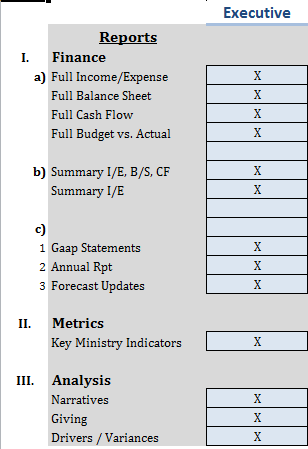As part of my Reporting Strategy Series, in this post, we’re going to talk about reporting to the Executive Team of your church. This might be the Pastor only but would include an Executive Pastor (XP) if one was on staff.
One purpose of this post is to inform Pastors of what kind of reports they should expect to help them make God- honoring decisions. Sometimes Pastors just don’t know. Secondly, it’s for the one doing the reporting – to design reports that meet the needs of the Pastor or Executive Team.
Let’s Dive In.
I. Financial Reports
a. In my view, the Executive Team gets the full Monthly Reporting Package of Income/Expense, Balance Sheet, Cash Flow and Budget vs. Actual. If Pastor has an XP, he may elect to just get summary reports and let the XP review the details and keep him abreast as needed.
b. The Executive Team would also receive any and all reports designed for other audiences because they need to understand them so they can be on the same page when talking/meeting with the other audiences – the most notable would be the Congregation and Elders or Board of Directors if you have either one.
c. Now, let’s look at 3 more financial reports:
1. GAAP Statements
These are required reports in specific formats. If your church isn’t following GAAP, then there’s no need to issue GAAP Financial Statements. Honestly, even if your church IS adhering to GAAP accounting rules, these reports aren’t really useful in the day to day management of the church anyway.
However, if your your church is adhering to GAAP, and/or has a CPA Firm reviewing/auditing the Financial Statements…you may want to include them in your…
2. Annual Report
First, I can’t say enough about telling the story of what Jesus did in His church ‘to your church’ at the end of each fiscal year. It’s also an opportunity to recast vision as to the upcoming year(s). In the section on Finances, I would suggest including the GAAP Statements mentioned above. This shows the church you’re doing accounting at a very high level per standards set forth by the FASB.
Obviously, since the Executive Team plays a major role in the development/direction of this Annual Report, they’d be the first to see it before the church.
3. Forecasts
These can be useful at each quarter-end just to reorient or alert the Executive Team of any known significant changes from the original budget. It’s also the primary tool to validate any upside/down plans the church may need to implement.
II. Metrics
To the extent you’re tracking Key Ministry Metrics, all should be made available to the SP/XP. The # of metrics being tracked organization-wide could be quite numerous, so the SP could elect to only look at the ones he deems most important and only dig if any are not tracking as expected.
I wrote a whole series on Ministry Metrics. Here’s the first in the series.
III. Analysis
One role of the Business Admin is to ensure the Executive Team understand the reports by providing meaningful analysis in these primary areas – 1) Giving 2) Expenses 3) Metrics and 4) Selected Balance Sheet Line Items in regards to Drivers and Results vs. Expectations.
In Closing:
Listen, I’ve not cornered the market on report designs for sure. Rather, I am offering these Reporting Strategy posts as food for thought.
Scroll down and share your thoughts in the comments. Subscribe to the blog while you’re there.
I hope you’ve found this post helpful to you in regards to what reporting to the Executive Team looks like.
In my next post in this series, we’ll take a look at what these reports may look like.
